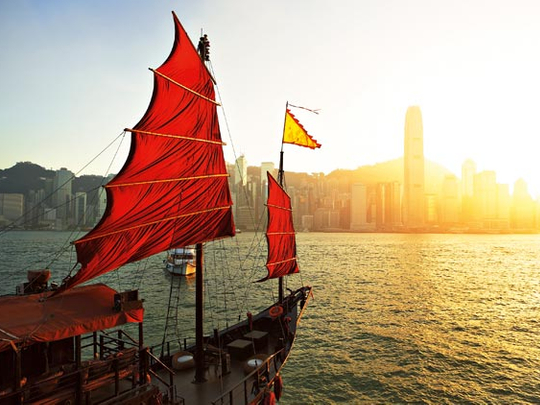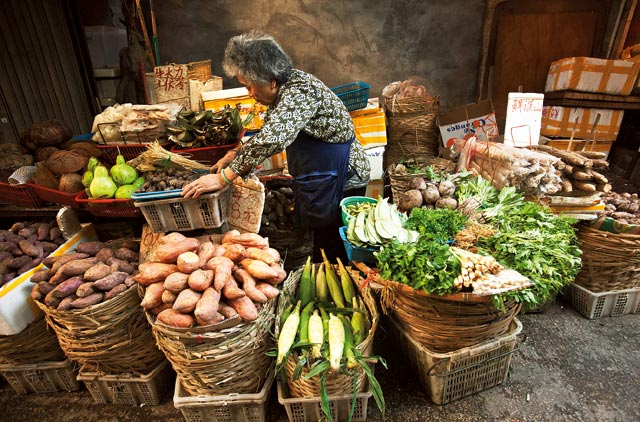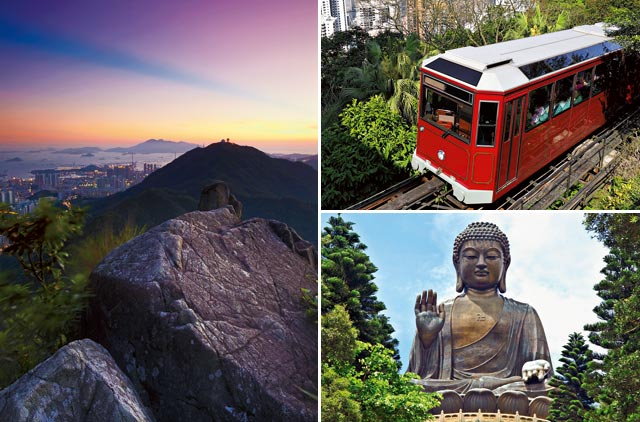
At the top of Victoria Peak, prepare to have the breath snatched away from you. The nighttime view is best – white and gold lights wink from the necks of skyscrapers, their sleek glass bodies shimmering in the inky water of Victoria Harbour. Crane your head over the edge for a spine-tingling taste of your own mortality – the roaring wind, sharp air and sheer drop all conspiring to turn your stomach to jelly.
At 552 metres above sea level, this spangled spectacle of Hong Kong’s Gotham City skyline puts the fascinating city-state into perspective. A frenzy of narrow streets, high rises and corporate logos, the central banking district shrinks to no more than a neon haze from this distance, the skinny buildings packed tightly as reeds around the harbour and flanked on all sides by mountains, golden beaches and luscious jungle. This spectacular panorama is why the top of The Peak has been the most fashionable place to live in Hong Kong ever since the British came here in 1842. The colonists built villas at the summit to escape the summer heat and, even after the hand over of power back to the Chinese in 1997, it remains home to the territory’s most expensive real estate, as well as its most unmissable tourist destination.
The best way to reach the top these days is on the Peak Tram, a funicular railway dating back to 1888 that brings passengers up from Hong Kong’s Central District. Whispers of the city’s colonial past linger in the Edwardian outfits and vintage posters on display at the tram entrance – reminders of a period when it was still customary for taipans to be carried up the perilous slopes in human-powered sedan chairs.
The steep topography is one of the most distinctive elements of Hong Kong, and as a result it’s as desirable a destination for hikers and campers as for city slickers. Split into three major areas – Hong Kong Island, Kowloon Peninsula and the mountainous New Territories – the urban areas are ever expanding, but nature is still putting up a good fight. From almost every angle, craggy mountain ranges dominate the horizon, tumbling plants burst out of unexpected roadside spots, while the state’s scattering of 263 islands lie in humped silhouettes in the glittering South China Sea.
Haute cuisine
The high rises, frenetic pace and cosmopolitan atmosphere of Hong Kong mean it is a strangely familiar-feeling place for the Dubai resident – only instead of shawarma and hummus, Hong Kong boasts noodles and dim sum. Experience the latter in all its glory in Lin Heung Tea House, a no-frills parlour in the Central District where you’ll be lucky to hear a snippet of English anywhere in the vicinity, or go high-end at Man Wah in the Mandarin Oriental hotel, where you can feast on delicious dumplings while admiring the excellent views.
With more than 11,000 eateries and 60 Michelin-starred venues to choose from, it can be hard to know where in the city to start, but a good bet is to head to buzzing Soho, a winding street choc-full of art galleries, nightclubs, and diverse restaurants, advertising everything from German to Japanese and Argentinian cuisine. The area’s vibrancy is partly thanks to the Central-Mid-levels escalator system, the longest outdoor covered escalator system in the world. Built in 1993, it was designed to help residents with the hilly terrain that is so characteristic of Hong Kong. It’s a rather bizarre sight – the stairs run downhill from 6.00am to 10.00am and uphill from 10.30am to midnight – so forgetting your wallet at home on the way to work could result in a very exhausting climb.
A pleasant ride in a junk boat or star ferry across the harbour from Hong Kong island takes you to Kowloon, which boasts an elegantly arched and colonnaded colonial structure that is the site of the old marine police station and one of Hong Kong’s few remaining historic buildings, now transformed into a hotel, shopping mall and heritage area known as 1881.
Next door is a cluster of luxury restaurants, all of which have dazzling views across the harbour of Hong Kong island lit up at night. At 8pm every night tourists can enjoy the Symphony of Lights, a light and music show recognised by Guinness as the world’s largest permanent sound and light show. We witnessed the spectacle from the comfort of Hutong, a luxurious Chinese restaurant evocative of a traditional Beijing house that featured innovative twists on regional Chinese cuisine including specialities such as poached jellyfish, vegetarian shark fin, Peking duck and delicious Shanghai dumplings.
Retail highs
Another height to scale for the Hong Kong visitor is the sheer number of shopping options. Literally meaning “fragrant harbour”, Hong Kong owes its name to the fragrant wood products that were once traded there and commerce is still a major draw, with the city’s shopping some of the world’s best. Chinese visitors from the mainland come in droves to take advantage of Hong Kong’s tax-free shopping in areas such as The Landmark Atrium, which holds the flagship boutiques of many famous fashion brands, and the city’s numerous retail districts feature everything from H&M to Hermes.
It’s not all international-brand buys though – there is much atmosphere to be soaked up at the many marketplaces around the city, one highlight of which is the Graham Street wet market – so called because of the frequent need to mop beneath the many fresh and dripping wares. At 160 years old it is Hong Kong’s oldest continuously operating street market and the most picturesque – stalls frame the steep and narrow road, stuffed full of plump and elaborate dragon fruits, shiny aubergines, crunchy pak choi and fragrant yellow pomelos. One of the more English-language-friendly markets, most of the stall owners are in their twilight years, having manned their stands all their lives.
Crossing with Graham Street is Hollywood Road, which dates back to 1844, pre-dating its Californian namesake, and so-called because of the ‘holy wood’ evergreen trees that line the street. This is the city’s best area for antiques, where you can find genuine and copies of Ming porcelain, Maoist paraphernalia, jade dragons, and, remarkably, an array of finely carved ornaments sculpted from Mammoth tusks – the legal alternative to elephant ivory, dug up from Russian glaciers. A short drive to the elegant coastal area of Stanley in the south of Hong Kong island brings yet another shopping opportunity. The winding seaside route holds magnificent views of the Tao Tam mountain range, while Stanley Market itself hosts an array of reasonably priced Chinese artwork, fabrics, textiles, tableware and other souvenirs. There’s also a pretty walk along the waterfront, where fishermen in traditional bamboo hats are silhouetted against the sky in their curved wooden boats.
Spiritual heights
For a less worldly taste of Hong Kong, Man Mo Temple near Hollywood is a striking monument to the gods of literature (Man) and war (Mo). Colourful glazed ceramic figurines depict stories from ancient Chinese operas on the temple façade, while a furnace burns outside, fuelled by the paper offerings of those seeking to send a message to departed loved ones. Inside you’re met with the sickly fug of hundreds of incense coils hung from the ceiling like fossilised snakes, silently dropping chalky ash as they disintegrate around the red rectangular prayers inside.
Meanwhile, a stone’s throw from Stanley Market is a temple dedicated to the fisherman goddess, a pretty building that boasts the rather poorly preserved hanging skin of a tiger, supposedly shot outside the temple by an Indian policeman in 1947, at a time when the creatures roamed the jungles of the Hong Kong mountains.
But for a real cultural highlight, hop on the underground across to Lantau Island, the largest outlying island in Hong Kong. Here you can catch the Ngong Ping 360 cable car, which offers ‘crystal cabins’ that have a clear glass floor, maximising the incredible views of the undulating hills, surrounding islands and South China Sea.
The climax of the journey is the breathtaking sight of the Tian Tan Buddha – a 34-metre high bronze statue and one of the five large statues of Buddha in China, which is visible from as far away as Macau on a clear day. You’re dropped off at Ngong Ping village, from which you can walk to the Po Lin Monastery, an ornate confection of Chinese-style architecture and gold detailing, veiled in a cloud of incense and vibrating with the sonorous chants of meditating monks.
While a pensive ascetic may sometimes be spotting wandering the surrounding lotus garden and coy carp ponds, you’ll definitely get a taste of their cuisine at the Po Ling Monastery cafeteria, which serves a selection of vegetarian meals featuring wholesome foods like mushroom soup, and tofu and sugar snap rice. Work off your lunch with a walk to the top of the ‘Big Buddha’, 200 steps rewarded by yet another magnificent panorama, encompassing Lantau Peak, the second-highest mountain in Hong Kong at 934 metres, as well as the rippling valleys and far off archipelago.
And here’s Hong Kong’s great contradiction – its rich past and mixed parentage makes it a land of both skyscrapers and incense, monasteries and Michelin stars, Buddha and Balenciaga. One thing’s for sure – whether it’s scaling a mountain, enjoying haute cuisine or admiring impressive vistas, the highlights of Hong Kong are literally higher than those of most cities. And what a view.













